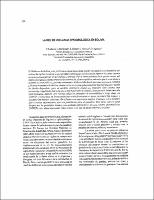La red de vigilancia epidemiológica en Bolivia
Date
1999Author
Metadata
Show full item recordAbstract
El Gobierno de Bolivia y las prefecturas departamentales juegan un papel de coordinadores del sistema de vigilancia mientras que la responsabilidad de recolección de datos en el campo asienta en una combinación del sector público y privado. Por lo tanto podemos decir que el cuerpo del sistema de vigilancia está compuesto de una armazón, el sector público, mientras que la musculatura la forma del sector público y privado combinados. El desarrollo de este sistema reconoce la realidad política y económica de Bolívia, donde existe un sistema gubernamental descentralizado y donde los fondos disponibles para un servicio veterinario estatal son limitados. Este sistema, aun pareciendo complicado, funciona bien y está mejorando la calidad y frecuencia de la información epidemiológica. Además, este sistema refleja los principios de sostenibilidad a largo plazo. La UNIVEP es consciente de la necessidad que existe de mejorar los datos, fortalecer los avances y mantener los vínculos existentes. En el futuro será importante ampliar el enfoque sobre la fiebre aftosa a otras enfermedades que son prioritarias para el ganadero. Esta tarea debería estar dirigida por los ganaderos mismos y las unidades informativas. De esta manera, el papel de las UNIVEPs tanto departamentales como central será más de asesoramiento y análisis. Trabajo presentado en el Seminario Internacional sobre Aspectos de la Vigilancia Aplicado a la Gestión Sanitaria en Áreas con Diferentes Status de la Fiebre Aftosa. Coordinado por el Centro Panamericano de Fiebre Aftosa (PANAFTOSA - OPS/OMS); 15-17 marzo 1999.
Subject
Collections
Related items
Showing items related by title, author, creator and subject.
-
Matus-López, Mauricio; Cansino Pozo, Desiderio; Cid Pedraza, Camilo; Valdés Romero, Werner (2018)[RESUMEN]. Objetivo. Evaluar desde los puntos de vista técnico y político la capacidad de Bolivia para generar espacio fiscal para salud que le permita sostener los avances y cumplir el compromiso de un gasto público en ...
-
Ortiz-Prado, Esteban; Acosta Castillo, Tamara; Olmedo-López, Mauricio; Armijos, Luciana; Ramírez, Darío; Iturralde, Ana Lucia (2017)Objective. To demonstrate the prevalence of cesearean sections (C-sections) in Ecuador and their distribution between private and public health centers. Methods. An observational population-based study was conducted of ...
-
Etienne, Carissa F.; Califf, Robert (2016)Una de las funciones básicas de la salud pública es la regulación en el ámbito de la salud. Cuando esta función se ejerce de manera eficaz, sirve para promover y proteger la salud de la población al asegurar la calidad, ...




